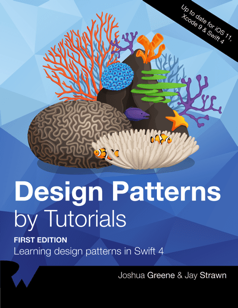Advanced Design Patterns — New!
This section covers design patterns that are very useful but only in rare or specific circumstances. These patterns may be exactly what you need for a particular case, but they may not be useful on every project. However, it’s best to be aware of them as you’ll undoubtedly run across them at some point in your development career.
New to this release, we’ve added the following five chapters:
-
Chapter 18: Flyweight Pattern: This creational design pattern minimizes memory usage and processing. It also provides objects that all share the same underlying data, thus saving memory. Learn about flyweight objects and static methods to return them.
-
Chapter 19: Mediator Pattern: This is a behavioral design pattern that encapsulates how objects, called colleagues for this pattern, communicate with one another. This pattern is useful to separate interactions between colleagues into an object, the mediator. Learn how to use it when you need one or more colleagues to act upon events initiated by another colleague.
-
Chapter 20: Composite Pattern: This is a structural pattern that groups a set of objects into a tree so that they may be manipulated as though they were one object. If your app’s class hierarchy forms a branching pattern, trying to create two types of classes for branches and nodes can make it difficult for those classes to communicate. Learn how to reduce complexity and solve this problem with this pattern.
-
Chapter 21: Command Pattern: This is a behavioral pattern that encapsulates information to perform an action into a command object. Learn how you can model the concept of executing an action and to use this pattern whenever you want to create actions that can be executed on different receivers.
-
Chapter 22: Chain of Responsibility Pattern: This is a behavioral design pattern that allows an event to be processed by one of many handlers. See how to use this pattern whenever you have a group of related objects that handle similar events but vary based on event type, attributes or something else related to the event.
Class diagrams for each chapter make it easy to understand what’s going on.
Where to Go From Here?
 Design patterns are incredibly useful, no matter what language or platform you develop for.
Design patterns are incredibly useful, no matter what language or platform you develop for.
Using the right pattern for the right job can save you time, create less maintenance work for your team and ultimately let you create more great things with less effort. Every developer should absolutely know about design patterns, and how and when to apply them. That’s what you’re going to learn in this book!
Move from the basic building blocks of patterns such as MVC, Delegate and Strategy, into more advanced patterns such as the Factory, Prototype and Multicast Delegate pattern, and finish off with some less-common but still incredibly useful patterns including Flyweight, Command and Chain of Responsibility.
And not only does Design Patterns by Tutorials cover each pattern in theory, but you’ll also work to incorporate each pattern in a real-world app that’s included with each chapter. Learn by doing, in the step-by-step fashion you’ve come to expect in the other books in our by Tutorials series.
Here’s how to get your hands on a copy:
Questions about the book? Ask them in the comments below!

